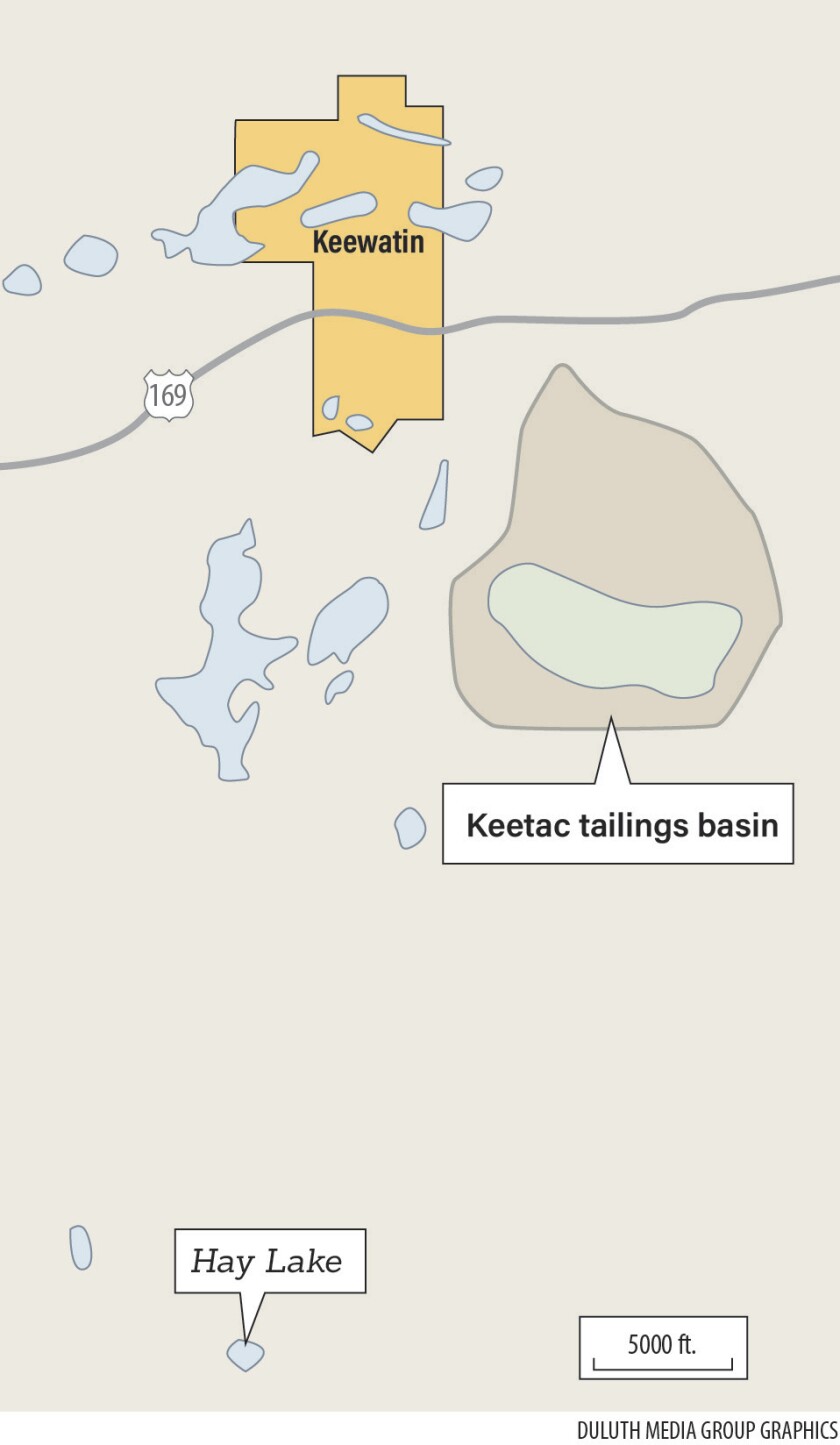KEEWATIN — As an Iron Range taconite mine appeals a decision by state regulators denying its request to allow sulfate levels in a downstream lake to remain nearly eight times higher than the standard for wild rice waters, federal regulators have alleged the facility violated sulfate limits on wastewater nearly 300 times over three years.
On May 15, the Environmental Protection Agency sent a notice of violation to U.S. Steel’s Keetac iron ore mine and pellet plant, alleging that it released wastewater with sulfate levels higher than the permitted amount 299 times into nearby waters between September 2019 and September 2022.
ADVERTISEMENT
“EPA has found that U.S. Steel has violated federally enforceable sulfate effluent limits required by the Facility’s National Permit Discharge Elimination System (NPDES) permits,” Michael Harris, the EPA’s division director for enforcement and compliance assurance division, wrote in a cover letter accompanying the notice of violation.
Harris said the alleged violations could be resolved through an EPA administrative compliance order, administrative penalty order or “bringing a judicial action.”
The documents were obtained by Minnesota environmental group CURE through a Freedom of Information Act request and first reported by the Minnesota Star Tribune.
The permits cover water released from Keetac’s tailings basin, where a slurry of water and fine pieces of crushed waste rock sit behind earthen dams, and its open-pit mine, limiting the monthly average sulfate in wastewater releases to 14 ppm and monthly maximum sulfate levels in wastewater releases to 24 ppm.
Those figures are designed to protect downstream wild rice waters from exceeding 10 parts per million or 10 milligrams per liter, Minnesota’s standard for wild rice waters.
Sulfate released into water from industrial processes such as mining and wastewater treatment can harm rice at elevated levels as it converts into hydrogen sulfide within the sediment.
But the mining industry had long argued the 10 ppm standard was too stringent.
ADVERTISEMENT
A 2015 state law sought to prevent the agency from adding impaired wild rice waters to the list and to prevent the state agency from enforcing sulfate reduction if it cost the permit holder any money. The MPCA had tried to change that standard to a formula that would include the water's organic carbon and iron content, but withdrew its rule change proposal in 2018.
The 2015 state law was designed to largely prevent the MPCA from enforcing the existing standard until it established new wild rice water-quality standards for sulfate. Additionally, a 2016 state law invalidated the sulfate water quality-based effluent limits and compliance schedule for Keetac.
In a statement to the News Tribune responding to the EPA’s enforcement action, U.S. Steel spokesperson Andrew Fulton maintained that the company is compliant with its permits based on Minnesota state law.
But over the last four years, the MPCA, under pressure from the EPA, has changed its tune.
When the MPCA submitted its 2020 impaired waters list to the EPA without any wild rice waters exceeding sulfate standards, the federal agency pushed back, identifying 30 bodies of water — including Hay Lake, which is downstream of Keetac — that it said should have been on the list.
The MPCA then began following the EPA’s rules, noting the federal Clean Water Act trumped state law.
Fulton added that there is no active sulfate treatment technology that U.S. Steel can evaluate, so it has tried and is trying several technologies to treat sulfate at Keetac and Mountain Iron’s Minntac, U.S. Steel’s other taconite mine and pellet plant.
ADVERTISEMENT
“U.S. Steel is committed to finding a solution that addresses sulfate at Keetac and Minntac,” Fulton said. “In addition, the convoluted history of the sulfate standard at the state level shows how difficult the sulfate problem is and how uncertain it is for regulated entities. We must be able to rely on and play by rules that are well grounded in science and law.”

The EPA’s notice of violation came shortly after U.S. Steel appealed a February decision by the Minnesota Pollution Control Agency to deny the company’s request for a site-specific standard allowing Hay Lake to have sulfate levels of 79 ppm — nearly eight times higher than the state standard.
MPCA said U.S. Steel’s request was “scientifically indefensible.”
A three-judge panel at the Minnesota Court of Appeals will hear oral arguments on the case Wednesday morning.
Paula Maccabee, executive director and counsel for environmental group WaterLegacy, filed an amicus curiae, or “friend of the court,” brief showing wild rice in Hay Lake was severely damaged as far back as 2009 and cited U.S. Steel data that showed Hay Lake’s average sulfate exceeding the existing state standard of 10 ppm, with average sulfate levels from 2009-2021 at 34 ppm and almost 48 ppm from 2016-2020.
In an interview, Maccabee said that if the court sides with U.S. Steel, the EPA’s enforcement would not move forward, but if the court sides with the MPCA, the state agency could use the EPA's findings to enforce the existing wild rice standard of 10 ppm.
“U.S. Steel didn’t come anywhere near close to making a case for an eight-times weaker standard than what’s in Minnesota rules,” Maccabee said. “So I think it is highly likely that the court will uphold MPCA’s decision, and then the EPA enforcement and permit, issued in 2011, will both be valid.”
ADVERTISEMENT
Fulton said U.S. Steel was disappointed in MPCA’s denial of a site-specific standard for Hay Lake and “enhanced treatment requirements” would mean “increased costs that reduce our competitiveness in the marketplace.”
“Importantly, we do not believe the increased requirements would result in healthier wild rice,” Fulton continued. “This chain reaction could have far-reaching negative economic impacts, harming the workforce and revenue generation benefits Keetac currently provides in the Iron Range.”
A coalition of Ojibwe and Dakota bands and tribal groups in Minnesota and Wisconsin, as well as the Minnesota Center of Environmental Advocacy, filed amicus curiae briefs in support of the MPCA’s decision to deny a site-specific standard.
“This case is about one thing: (U.S. Steel) seeks yet again to excuse its own failure to fix its own pollution,” the tribal coalition wrote in their October brief. “But the wild rice rules mean what they say and Hay Lake is properly classed as a ‘water used for production of wild rice’ within the meaning of controlling state and federal law.”














